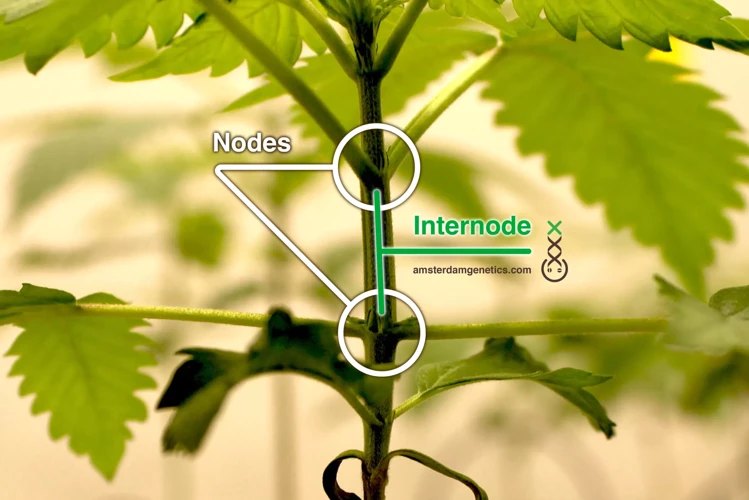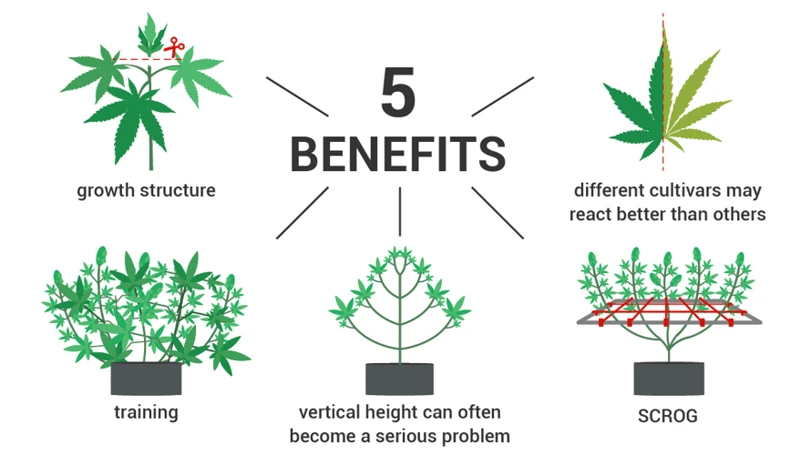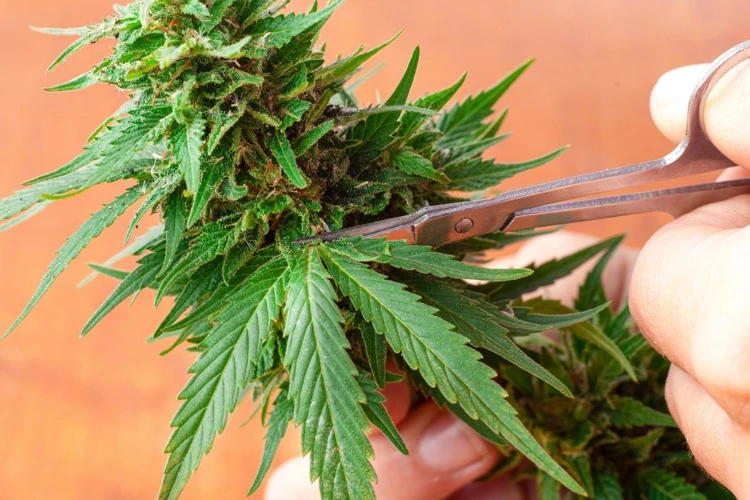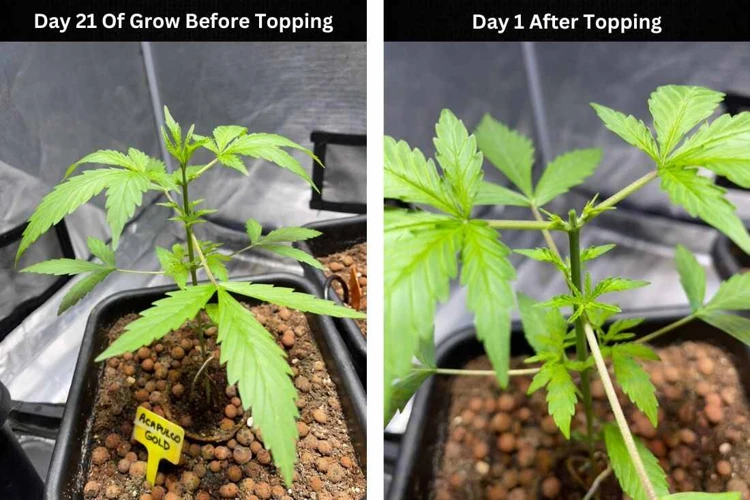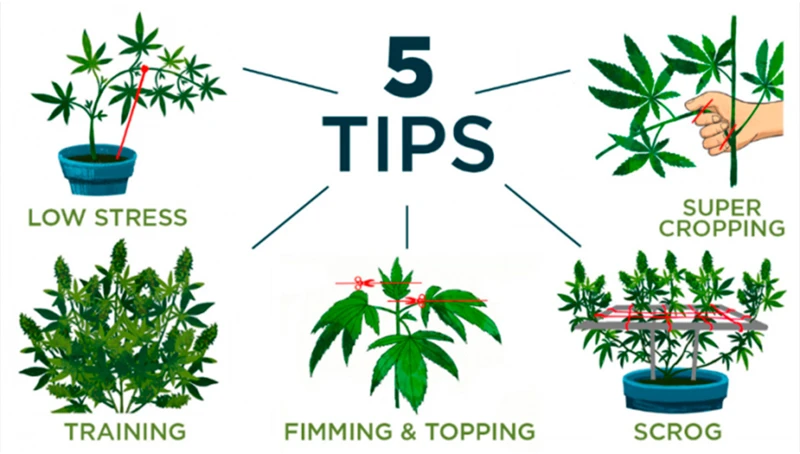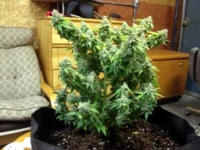
The Pros and Cons of Topping Cannabis Plants
Cultivating cannabis can be an intricate process, and growers are constantly exploring new techniques to improve their yields and overall results. One of the most interesting methods is topping cannabis. Have you heard of it? Topping is a method that involves removing the tip of the main stem of a cannabis plant to stimulate the growth of lateral branches. This technique may sound intimidating to first-time growers, but its potential benefits could make it worth considering. In this article, we’ll dive deep into the process of topping and explore its advantages and disadvantages as well as how and when to do it correctly.
What is Topping Cannabis?
Contents
Topping cannabis is a technique used by growers to improve the overall health and yield of their plants. This process involves removing the top portion of the main stem, which encourages the plant to branch out and grow more buds.
The Process of Topping
Topping is a simple process that involves cutting off the top of the main stem, also known as the apical meristem. This is usually done when the plant is in the vegetative stage and has grown several nodes.
Why Top Cannabis Plants?
Topping cannabis plants is beneficial for a number of reasons. Firstly, it can increase yields by encouraging the plant to grow more buds. Secondly, it allows for greater control over the shape and size of the plant, which can be important for growers with limited space or wanting to optimize their cultivation setup. Additionally, topping can improve THC levels by increasing bud development and reducing the amount of energy the plant puts into growing leaves. Finally, topping can help to produce an even canopy, making it easier to manage light distribution and promote uniform growth of the plant.
Topping cannabis is a popular technique among growers looking to improve the health and yield of their plants. While there are some drawbacks to consider, such as slower growth and increased risk of infection or pests, the benefits of topping are well worth the effort for many growers.
The Process of Topping
Topping cannabis is a common plant training technique that involves the removal of the top growth of a plant, which can be a daunting process for some growers. This technique can significantly boost yields, as well as the quality of the harvested buds, but is not without risks. Before deciding to top your cannabis plants, it is essential to understand the process of topping, including the tools needed and the steps involved, to ensure the best possible results. Let’s take a closer look at the process of topping cannabis plants.
Why Top Cannabis Plants?
There are several reasons why cannabis growers may choose to top their plants. Some of these reasons include:
- Desire for higher yields
- Control over plant shape and size
- To improve THC levels
- Evening out the canopy
By topping their cannabis plants, growers can encourage bushier, more robust growth that can lead to higher yields. Topping can allow for greater control over the plant’s shape and size, making it easier to fit into a certain grow space or training method. By removing the top of the main stem, the plant will grow more lateral branches, which can also help to even out the canopy and promote more even growth overall.
Furthermore, topping can also lead to an increase in the THC levels in the plant as it directs more energy towards the remaining buds. However, there are also some drawbacks to consider, including slower growth and an increased risk of infection or pests. It’s important for growers to carefully consider whether topping is the best choice for their particular plant and growing conditions.
Benefits of Topping Cannabis Plants
Topping cannabis plants can provide numerous benefits that can help growers maximize their yields and produce healthier plants. Let’s dive deeper into the advantages of topping cannabis plants.
Increase Yields
One of the most significant benefits of topping cannabis plants is that it can significantly increase yields. When topping the plant, growers remove the top of the main stem, which encourages new branches to grow. More branches mean more budding sites, resulting in larger yields.
Control Plant Shape and Size
By topping, growers can also control the shape and size of their cannabis plants. When the top of the main stem is removed, the plant typically grows into a bushier shape, making it ideal for plants with limited space or height. This technique allows growers to manipulate their plants’ growth patterns to better fit their grow space or preferences.
Improve THC Levels
Topping cannabis plants can also improve the THC levels in the plant’s buds. When growers top their plants, more energy is directed towards growing new shoots instead of stretching the main stem. This energy is then concentrated on producing high-quality buds, resulting in increased THC content.
Even Out Canopy
Another benefit of topping cannabis plants is that it can help even out the canopy. When the top of the main stem is removed, the plant’s lower branches are encouraged to grow upward, creating a more even canopy. This can improve light distribution and increase the number of budding sites, ultimately leading to higher yields.
The benefits of topping cannabis plants are numerous, including increased yields, better control over plant size and shape, improved THC levels, and evened-out canopies. However, it is essential to consider the drawbacks before proceeding with this technique.
Increase Yields
One of the major benefits of topping cannabis plants is the potential increase in yield. By utilizing this technique, growers can encourage the plant to produce more secondary branches, which can lead to more flowering sites and ultimately, a higher yield of buds. This can be particularly advantageous for growers who may have limited space or resources, as it allows them to maximize their yield without needing to cultivate additional plants. Additionally, increased yields can translate to more product for consumers or higher profits for growers, making topping an attractive option for many.
Control Plant Shape and Size
One of the benefits of topping cannabis plants is the ability to control the shape and size of the plant. By cutting off the tip of the plant, you encourage it to grow out sideways instead of continuing to grow upwards. This can result in a bushier plant with more potential bud sites.
| Shape | Size |
|---|---|
| Taller and thinner | Larger, fewer bud sites |
| Shorter and bushier | Smaller, more numerous bud sites |
This can be especially beneficial for indoor growers who have limited height in their grow space. By topping the plant, they can keep it at a more manageable height while still achieving a good yield. Outdoor growers can also benefit from topping their plants as it can help them blend in with surrounding foliage and make them less visible.
It is important to note that the final shape and size of a topped cannabis plant will depend on several factors including strain, light source, and nutrients. It is also crucial to properly train and support the plant to ensure that it can handle the weight of its buds.
The ability to control the shape and size of cannabis plants through topping is a useful technique for growers looking to maximize their yields and optimize their grow spaces.
Improve THC Levels
One of the benefits of topping cannabis plants is that it can improve the THC levels in the plant. THC, or tetrahydrocannabinol, is the psychoactive component in cannabis that is responsible for the “high” that users experience. When cannabis plants are topped, they produce more secondary branches, which can lead to an increase in the overall yield of the plant. This increase in yield often means that there is more THC produced as well.
How does topping increase THC levels?
When cannabis plants are topped, they are encouraged to produce more branches and grow bushier. These new branches have the potential to become flowering sites, which means that the plant can produce more buds. More buds means more trichomes, the tiny resin glands that contain THC, CBD, and other cannabinoids.
What are the other factors that affect THC levels?
While topping can certainly help increase THC levels, there are other factors that can contribute as well. Genetics play a big role in the amount of THC a cannabis plant will produce. Some strains naturally have higher THC levels than others.
Environmental factors also come into play. Plants grown in optimal conditions, such as with the right temperature, humidity, and nutrients, are more likely to produce higher THC levels. Additionally, stress during the flowering phase can cause plants to produce more resin, leading to higher THC levels.
What are the potential drawbacks of focusing too much on THC levels?
While THC is certainly an important factor for many cannabis users, it’s not the only component that is important. Other cannabinoids, such as CBD, have medicinal properties that can benefit users as well. Additionally, high THC levels may not be desirable for some users, particularly those who are more sensitive to the psychoactive effects of cannabis.
Focusing too much on THC levels can lead to a “more is better” mentality that can prioritize yield over quality. It’s important to consider the overall cannabinoid profile, as well as the flavor, aroma, and appearance of the final product when evaluating the quality of cannabis.
Even Out Canopy
Creating an even canopy is important for maximizing the amount of light that reaches all parts of the plant. This is where topping can be especially useful. By removing the top of the plant, lower branches will have a chance to grow and become more developed. This creates a more level canopy and helps all parts of the plant receive equal amounts of sunlight.
Another way to even out the canopy is through a technique called low stress training (LST). This involves gently bending the branches downwards and away from the middle of the plant to create a wider canopy. Using LST in combination with topping can help create a more uniform canopy and improve overall yields.
However, it’s important to note that while an even canopy can be beneficial, care must be taken not to over-stress the plant by manipulating it too much. Frequent bending and manipulation of the branches can cause stress, slow growth, and reduce overall yields. A balanced approach to topping and LST is important in creating an even canopy without compromising the health and growth of the plant.
Even out canopy is an important part of creating a healthy and productive cannabis plant. Topping can be an effective way of achieving this, but it should be used in conjunction with other techniques such as LST to ensure the best possible results.
Drawbacks of Topping Cannabis Plants
While topping cannabis plants has many benefits, there are also some drawbacks that growers should be aware of. One potential drawback is slower growth. When a plant is topped, it needs time to recover and redirect its energy to new growth, which may slow down the overall growth rate. This can be a concern for growers who are looking to maximize yield within a specific timeframe.
Another concern is the increased risk of infection or pests. When a plant is cut, it leaves an open wound that can attract unwanted invaders. Growers need to be diligent about monitoring their plants for any signs of infection or pests and taking immediate action to address any issues that arise.
A less predictable outcome is also a risk. While topping can result in a more even canopy and improved yield, it can also lead to unexpected plant growth patterns. This can make it difficult for growers to predict how their plants will develop and may require more frequent monitoring and adjusting.
It’s important for growers to carefully consider the potential drawbacks of topping before deciding to implement this technique. Proper care and attention to the plants can minimize these risks and potentially lead to even greater benefits in the long run.
Slower Growth
One of the potential drawbacks of topping cannabis plants is that it can lead to a slower growth rate than plants that are left to grow naturally. This can be a perplexing issue for growers who are looking to maximize their yields and get the most out of their plants. While there are some benefits to topping, it’s important to weigh them against the potential drawbacks before deciding whether or not to top your cannabis plants. Let’s take a closer look at this slower growth issue and what it means for your plants.
Increased Risk of Infection or Pests
When you top a cannabis plant, you create an open wound where the top of the plant has been removed. This wound can make the plant more susceptible to infection or pests. It’s essential to take precautions to prevent these potential issues.
There are a few things you can do to reduce the risk of infection or pests when topping cannabis plants. First, you’ll want to make sure to use clean pruning tools. Disposable gloves can also be helpful to prevent the spread of any potential germs.
Ways to reduce the risk of infection or pests when topping cannabis plants:
| Method | Description |
|---|---|
| Use clean pruning tools | Disinfect pruning tools before using them on plants to prevent the spread of disease. |
| Wash hands before handling plants | Wash hands thoroughly before handling plants to prevent the spread of germs. |
| Keep the area clean and free of debris | Rake up and dispose of any fallen leaves, twigs, or debris in the area around the plants. |
| Use organic pest control methods | Limit the use of pesticides and try using organic methods for pest control, such as neem oil or insecticidal soap. |
| Monitor plants closely | Check your plants regularly for signs of pests or disease, so you can address any issues promptly. |
Despite the increased risk of infection or pests when topping cannabis plants, it’s essential to remember that good hygiene practices and implementing preventative measures can help keep your plants healthy and thriving.
Less Predictable Outcome
One of the potential drawbacks of topping cannabis plants is the less predictable outcome. While topping can increase yields and control the shape and size of the plants, it can also lead to some unintended consequences. Here are some factors that can affect the outcome of topping:
| Factor | Description |
|---|---|
| Genetics | The genetics of the plant can play a role in how it responds to topping. Some strains may respond well and produce more bud sites, while others may suffer stunted growth or produce lower yields. |
| Timing | The timing of the topping can determine how the plant responds. If topped too early, the plant may not have had enough time to establish a strong root system and could suffer setbacks in growth. If topped too late, the plant may have already started to flower and topping could cause stress, leading to lower yields. |
| Technique | The way the topping is done can also affect the outcome. Improper technique could result in damage to the plant, slowing down growth or causing it to become more susceptible to infections or pests. It is important to make a clean cut and ensure that the plant is healthy enough to handle the topping. |
| Environment | The environment in which the plant is grown can also impact its response to topping. Factors such as temperature, humidity, light, and nutrients can all affect the plant’s growth and development. Sudden changes in any of these factors could cause stress to the plant and impact the outcome of the topping. |
While the unpredictable outcome of topping can be concerning, it is important to keep in mind that with proper technique and care, the benefits of topping cannabis plants can outweigh the potential drawbacks. By carefully monitoring the plants and adjusting their environment as needed, growers can increase their chances of a successful outcome.
When to Top Cannabis Plants
One of the most critical factors when it comes to topping cannabis plants is timing. Topping should be done at the correct stage of growth to ensure the best possible results. There are two stages at which it is ideal to top cannabis plants: the vegetative stage and the early flowering stage.
During the vegetative stage, the plant is focused on growth and will have many branches. Topping during this stage will encourage the plant to grow new branches and make for a bushy and wide canopy. When topping during this stage, it’s important to wait for the plant to develop at least three to four nodes before making the cut. This will give the plant a strong foundation to grow from and will ensure a more even canopy.
During the early flowering stage, the plant has started to develop buds, and the focus shifts from growth to bud development. Topping during this stage will slow down the growth of the plant, but it will encourage the plant to bush out and develop more colas or bud sites. When topping during this stage, it’s important to make the cut before the buds become too large, as this can stress the plant and reduce yields.
It’s essential to keep in mind that the timing of topping cannabis plants will vary based on the strain and growing conditions, so understanding the stages of cannabis growth is crucial to timing topping correctly. It’s also important to avoid topping too late in the growth cycle, as this can severely impact the plant’s overall growth and development.
Vegetative Stage
During the early stages of growth, cannabis plants go through a vegetative phase where they focus on developing a strong root system and producing lush green leaves. It is during this phase that cannabis plants can benefit from topping. However, it can be perplexing to know when exactly to top your cannabis plant during the vegetative stage. Understanding the plant’s growth patterns and knowing what to look for can help you determine the best time to take this step in the plant’s development. Let’s explore the vegetative stage and when it is ideal to top your cannabis plants.
Early Flowering Stage
During the early flowering stage, topping cannabis plants can be a bit more challenging and potentially risky compared to topping during the vegetative phase. However, it can also provide some unique benefits for the final harvest.
Timing: When topping during the early flowering stage, it’s important to do so within the first two weeks after flowering has begun. Any later and the plant may already be putting its energy into buds and not producing new growth points from the topping.
Benefits: The biggest benefit to topping during the early flowering stage is that it can create a bushier, fuller plant and potentially increase yields. It can also encourage the plant to produce more colas, leading to potentially more diverse buds at harvest.
Drawbacks: The main drawback to topping during the early flowering stage is the risk of major stress to the plant. Any stress during this phase can potentially stunt bud growth, affect the overall potency of the buds, and ultimately lead to a lower yield. This is because the plant is already putting much of its energy into producing buds and may not be able to quickly recover from the topping.
Considerations: Before topping during the early flowering stage, it’s important to assess the overall health and growth of the plant. If there have been issues with nutrient deficiencies or pest infestations, topping can further stress the plant and potentially lead to more issues. It’s also important to properly support and train the plant after topping to ensure it can recover and continue to grow properly.
| Timing | Benefits | Drawbacks | Considerations |
|---|---|---|---|
| Within first two weeks of flowering | Create a bushier, fuller plant potentially leading to increased yields and diverse buds | Potential stress leading to stunted bud growth and lower yield | Assess overall plant health and provide proper support and training after topping |
How to Top Cannabis Plants
When it comes to topping cannabis plants, it’s important to have the proper tools and technique to ensure the process is successful. Here’s a step-by-step guide on how to top cannabis plants:
Tools Needed:
– Sharp pruning shears
– Rubbing alcohol
– Clean gloves
Step-by-Step Guide:
1. Put on your clean gloves to prevent any transfer of bacteria or fungus onto the plant.
2. Clean your pruning shears with rubbing alcohol to ensure they are sterile.
3. Identify the top node on the main stem of your cannabis plant.
4. Use your pruning shears to make a clean cut directly above the top node at a 45-degree angle.
5. Remove any remaining growth below the cut, leaving only the top set of fan leaves.
6. Monitor the plant closely after topping to ensure it is healing properly and new growth is emerging.
By accurately following the above steps, you can successfully top your cannabis plants and boost your yields. However, it’s important to note that topping requires practice and patience. It’s a skill that can take some time to perfect, so don’t be discouraged if your first attempt doesn’t yield the desired results. Keep practicing, and you will eventually become a pro at topping cannabis plants.
Tools Needed
Before you begin the process of topping your cannabis plants, it’s important to ensure that you have the right tools. Having the proper equipment can make the process much simpler and reduce the likelihood of damaging your plants. You will need a few specific tools in order to successfully top your plants. Let’s take a look at some of the essential tools you will need to have on hand.
Step-by-Step Guide
Step-by-Step Guide:
| Step 1: | Choose the plant to top. Select a plant that is healthy and has grown at least 4-5 nodes (a node is where the leaves and branches grow from the main stem). |
| Step 2: | Prepare your tools. Make sure you have a sharp and sterile pair of pruning shears or scissors. |
| Step 3: | Identify the top node. Look for the node at the very top of the plant. This is the node where you will make your cut. |
| Step 4: | Make the cut. Use your pruning shears or scissors to make a clean cut about 1/4 inch above the top node. Be careful not to damage any other parts of the plant. |
| Step 5: | Remove any lower growth. After making the cut, remove any growth below the cut to ensure that the plant focuses its energy on the upper growth. |
| Step 6: | Apply a sealant (optional). Some growers prefer to apply a sealant to the cut to prevent infection, but this is not necessary if your tools are sterile and the plant is healthy. |
Note: It is important to only top your plant once during the vegetative stage. If you top your plant too late or too often, it can cause stress and reduce yields. It is also important to give your plant time to recover after topping before initiating any further training or pruning techniques.
Caring for Topped Cannabis Plants
After topping your cannabis plants, it is important to pay extra attention to their care. The newly formed branches will require special care and attention in order to continue growing healthily.
Watering and Feeding: Topped plants require a bit more water and nutrients than their untopped counterparts. This is because topping can put additional stress on the plant, so it needs more resources to heal and continue growing. Make sure to give your topped cannabis plants enough water and nutrients, but be careful not to overdo it. Too much water or fertilizer can damage or even kill your plants.
Training and Support Techniques: Supporting your topped cannabis plants is essential to maintain their health and improve their overall growing performance. You can use plant ties or stakes to keep the plant erect and prevent the branches from breaking. Additionally, training techniques like LST (low-stress training) or HST (high-stress training) can be employed to enhance the overall yield of your cannabis plant.
It is also important to prune your plants regularly to remove any dead or decaying material as it can attract pests and cause diseases. Ensure that the plant has enough space between the soil and the bottom branches to avoid moisture-related issues.
Conclusion: Topping your cannabis plants come with great benefits but it requires careful consideration for their maintenance. Proper care, like watering and feeding, training, and pruning, is important to ensure a healthy and bountiful harvest. By following these simple practices, you can reap the rewards of topping your cannabis plants while making sure they remain healthy and strong throughout the growing process.
Watering and Feeding
Ensuring proper watering and feeding is crucial for the health and success of any cannabis plant, especially those that have been topped. However, this can be a perplexing task for novice growers due to the intricate balance of nutrient uptake and pH levels. In this section, we will delve into some essential tips and techniques to ensure your topped cannabis plants receive the proper care they need for optimal growth and yield. From understanding the importance of proper pH levels to implementing appropriate nutrient schedules, this guide will help you navigate the complexities of watering and feeding your topped cannabis plants.
Training and Support Techniques
When it comes to training and supporting topped cannabis plants, there are several techniques that can be used to ensure that the plants grow in the desired shape and direction. Here are a few techniques to consider:
- LST (Low Stress Training) – this involves gently bending and tying down the main stem of the plant, encouraging the growth of other lateral branches to create a more even canopy. This technique can be done using soft wires or plant ties, and can help increase yields by exposing more of the plant to light.
- SCROG (Screen of Green) – this technique involves placing a screen or netting over the top of the plants and weaving the branches through the holes in the screen as they grow. This helps create an even canopy and ensures that the buds are all exposed to light. This technique is particularly effective for plants that have been topped and have multiple lateral branches.
- Trellising – similar to the SCROG method, trellising involves using a mesh or wire frame to support the plant as it grows. This can help to prevent the branches from breaking under the weight of the buds, and can also encourage more airflow around the plants, reducing the risk of pests and diseases.
- Supercropping – this technique involves gently pinching and bending the branches of the plant to create a wider canopy and increase overall yields. This can be done by applying pressure to the stem until it makes a slight popping sound, indicating that the internal structure of the plant has been damaged enough to encourage new growth.
It’s important to note that these techniques should be used with caution, as too much stress or damage to the plants can be detrimental to their overall health and yield. Additionally, it’s important to monitor the plants regularly and adjust the training methods as needed to ensure that they are growing in the desired shape and direction. By using these methods in conjunction with topping, growers can create healthy, high-yielding cannabis plants that produce quality buds.
Conclusion
In conclusion, topping cannabis plants can provide a range of benefits for growers. By cutting off the top growth, growers can improve the overall yield, control the shape and size of the plants, and even out the canopy for a more consistent grow. However, there are also some drawbacks to topping, such as slower growth and a greater risk of infection or pests.
When deciding whether or not to top your cannabis plants, it’s important to consider the stage of growth and the outcome you’re hoping to achieve. Topping during the vegetative stage can help promote bushier growth and a more even canopy, while topping during the early flowering stage might be better for reducing plant height and improving overall yield.
If you do decide to top your plants, make sure you have the right tools on hand and follow a step-by-step guide to ensure a successful cut. Additionally, it’s important to care for your topped plants properly with regular watering and feeding, as well as training and support techniques to help the plants adapt to the new growth patterns.
Overall, topping cannabis can be a useful technique for maximizing yields and improving plant health, but it’s important to weigh the potential benefits against the drawbacks and make an informed decision based on the specific needs of your grow. With careful planning and attention to detail, topping can help you achieve a successful and bountiful cannabis harvest.
Frequently Asked Questions
Can any cannabis plant be topped?
Yes, almost any strain of cannabis can be topped, however, certain strains may respond better to topping than others.
How many times can a cannabis plant be topped?
A cannabis plant can be topped multiple times, but it’s recommended to only top once or twice during the vegetative stage.
Does topping cannabis plants affect potency?
Yes, topping can increase THC levels in the plant by allowing for more light and proper nutrients to reach lower branches.
Can topping cannabis plants cause damage?
Improper topping techniques can lead to damage or even stunt the growth of the plant. It’s important to follow proper instructions and use sterilized tools to prevent infection.
What is the best time to top cannabis plants?
The best time to top cannabis plants is during the vegetative stage or early flowering stage.
Will topping cannabis plants increase yields?
Yes, topping can increase yields by allowing for more buds to develop on lower branches and promote lateral branching.
What tools do I need to top my cannabis plants?
You will need sterilized pruning shears or scissors to top your cannabis plants.
How long does it take for topped cannabis plants to recover?
It can take 1-2 weeks for topped cannabis plants to recover and resume growth.
Do I need to support my topped cannabis plants?
Yes, topped cannabis plants may require support techniques such as trellising or staking to prevent branches from breaking due to the weight of buds.
Can I still use other training techniques on topped cannabis plants?
Yes, other training techniques such as LST or super cropping can still be used on topped cannabis plants to further increase yields and control plant shape.

